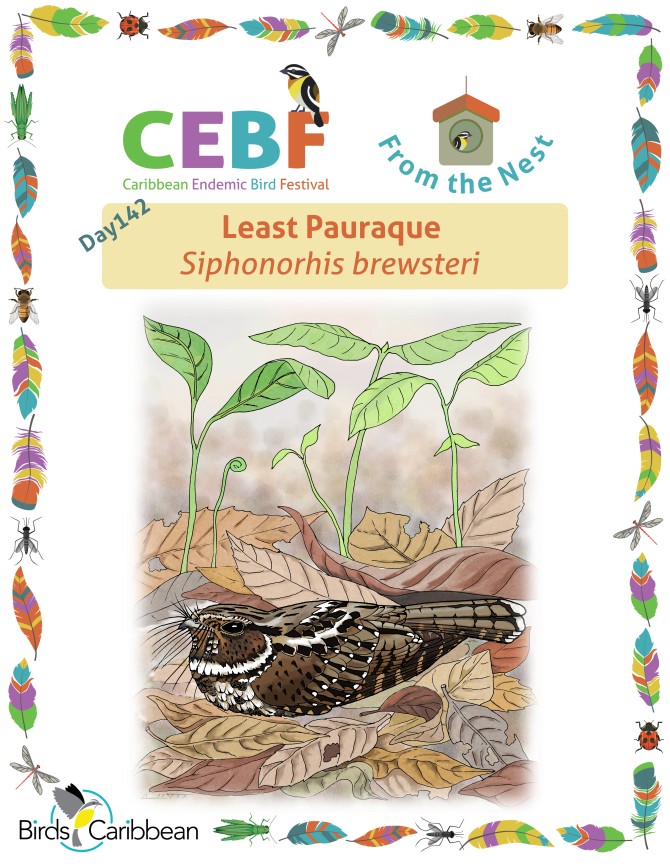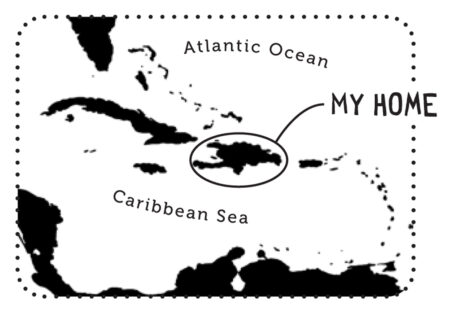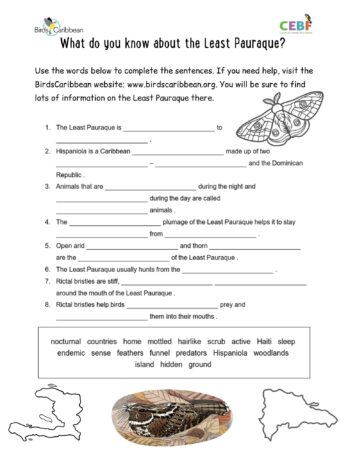Celebrate the Caribbean Endemic Bird Festival (CEBF) with us! Our theme in 2024 is “Protect Insects, Protect Birds”—highlighting the importance of protecting insects for birds and our environment. Have fun learning about a new endemic bird every day. We have colouring pages, puzzles, activities, and more. Download for free and enjoy learning about and celebrating nature!
Endemic Bird of the Day: Least Pauraque
You’re enjoying a nice relaxing night in the southwestern dry forests of the Dominican Republic when you hear an eerie “twooorii” from the forest. Is it a ghost?? Or even worse—the fabled Chupacabra!?
Although the avian family name Caprimulgidae does actually hail from myths purporting that these birds suckled (chupa) on goats’ (cabra) udders, the Least Pauraque couldn’t be more of an adorable toasted marshmallow of a bird with no interest whatsoever in drinking goat milk. They are actually far more interested in eating nocturnal flying insects—which is great news for all of us who don’t fancy nights filled with mosquitos!
These birds are locally known as ‘Torico’. Their local names come from their guttural repeated “torico, torico” call.
And while you might wander into the woods seeking to find the source of these spooky calls—you’ll be looking for a long time as these birds are masters of disguise! They are cryptically colored with streaked blackish-brown upper parts and a creamy white belly with feathers laced in blacks and browns. They wear a pearly white collar and search for insects with their huge, dark eyes—all the better for nocturnal foraging! You can tell them apart from Hispaniola’s other nightjar (the endemic Hispaniolan Nightjar) by the band across the end of their tail feathers which is white in males and buffy-cream in females. They also lack the white wing crescents of Antillean Nighthawk and much prefer perching and sallying to actively soaring like the nighthawks tend to do. While it might look like they can’t catch much in their tiny beaks, their mouths actually open very wide to catch unsuspecting insects.
Whilst they do share Hispaniola with several other nightjars, the Least Pauraque is unique in their genus! They used to share their genus with the Jamaican Pauraque, which although discovered first in 1758, has not been seen or detected since 1860. The Least Pauraque on the other hand is newer to science, having been described in 1917 and was later assigned to the same unique genus in 1928 by the notable James Bond.
You can find them in arid or semi-arid lowlands of Hispaniola. They are big fans of scrubby limestone woodlands filled with prickly cactus and thorn scrub, though they have also been recorded in deciduous, coniferous, and other mixed forests spanning from sea level up to 800m in elevation. The best spot to find the Least Pauraque is the Sierra de Bahoruco mountain range in the southwest of the Dominican Republic.
While not globally threatened, these adorable bug-eaters are considered near-threatened. Since they are hard to find and thus hard to count, we can only roughly estimate their population which is believed to be between 6,000-15,000 individuals. This population is suspected to be in a slow decline. Their current status in Haiti is not well known, wide-scale deforestation for agriculture and charcoal production mean they have lost much of their preferred habitat. In fact, there were no records of Least Pauraque in Haiti between 1928 and 1969! They are known at 16 widespread locales in the Dominican Republic—however, their cryptic plumage keeps them well hidden and it is believed that they likely occupy more areas than these. Continued threats include predation from introduced rats and mongoose, and continued forest loss for agriculture.
While decisions about protecting habitats from unsustainable development that can threaten the Least Pauraque are often in the hands of policy makers, you can still help your backyard birds thrive! Just like the Least Pauraque there are other birds, like the Gray Kingbird and Greater Antillean Bullfinch, that like to feed on crunchy and gooey insects. Avoid using insecticides so that these birds will have enough insects to munch on and keep coming back to your garden.
Learn more about this species, including its range, photos, and calls here. Great news! If you’re in the Caribbean, thanks to BirdsCaribbean, you have free access to Birds of the World and you can find out even more in the full species account of this bird!
Thanks to Arnaldo Toledo for the illustration and Holly Garrod for the text!
Colour in the Least Pauraque
Download our West Indies Endemic Bird colouring page. Use the photos below as your guide, or you can look up pictures of the bird online or in a bird field guide if you have one. Share your coloured-in page with us by posting it online and tagging us @BirdsCaribbean #CEBFfromthenest
Listen to the calls of the Least Pauraque
The calls of the Least Pauraque include a rising whistle “tooooooeeeeeee,” and a three syllable trilled “oo-weee-oo.”
Puzzle of the Day
Click on the image below to do the puzzle. You can make the puzzle as easy or as hard as you like – for example, 6, 8, or 12 pieces for young children, all the way up to 1,024 pieces for those that are up for a challenge!
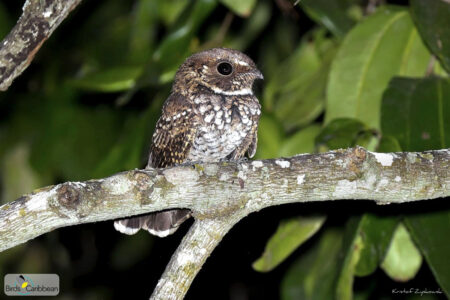
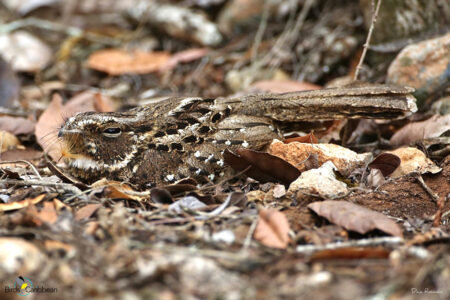
Activity of the Day
FOR KIDS : What facts can you remember about today’s endemic bird – the Least Pauraque? Test your knowledge by filling in the missing words in our Least Pauraque facts! We have given you all the correct words to use but can you put them into the right fact?
You can re-read the information all about this bird above, or search on the BirdsCaribbean webpages or online for more information about the Least Pauraque! Then, when you have completed all the sentences, you can check your answers here.
FOR KIDS AND ADULTS : Enjoy this video of a Least Pauraque in the wild!

